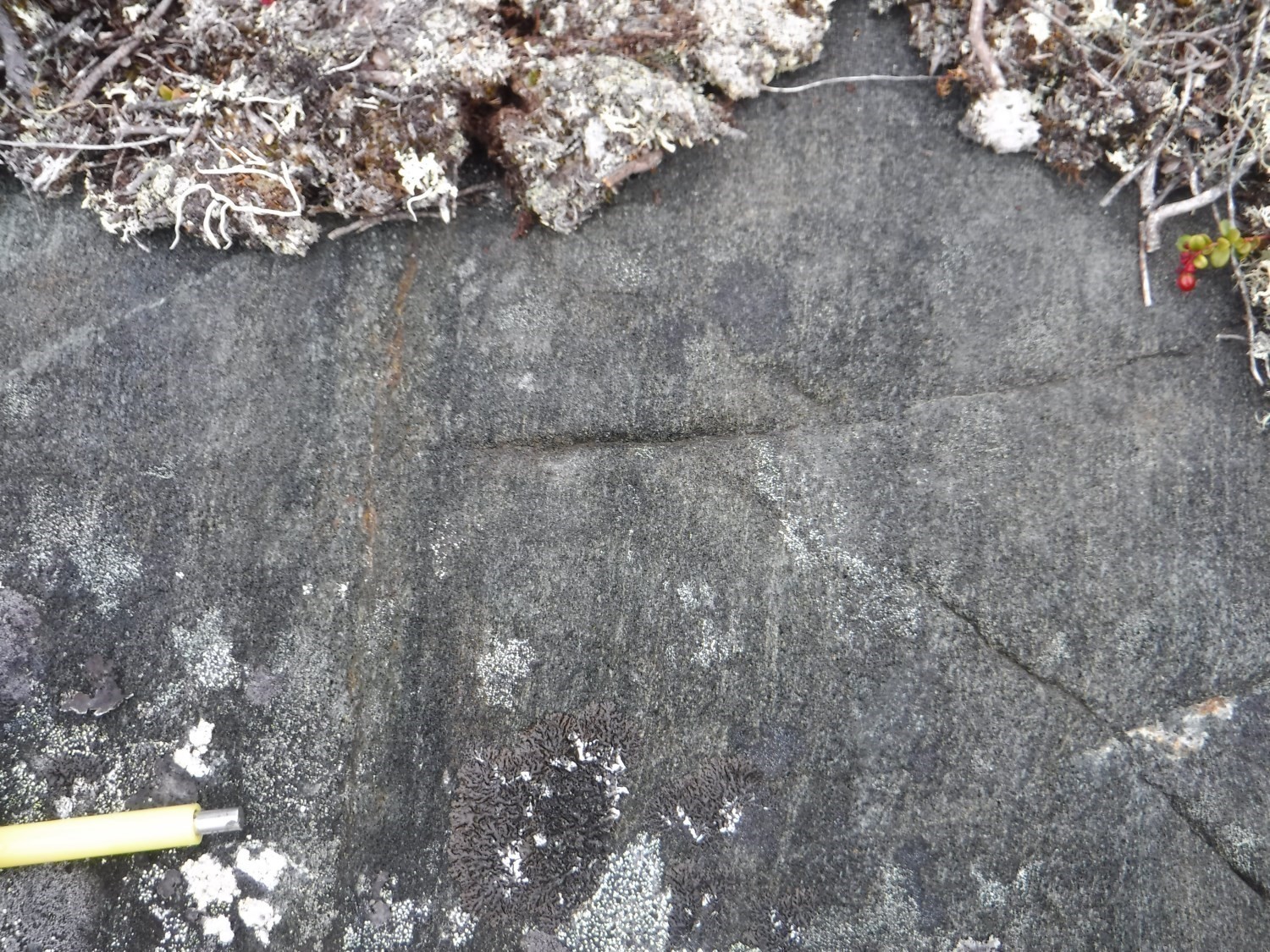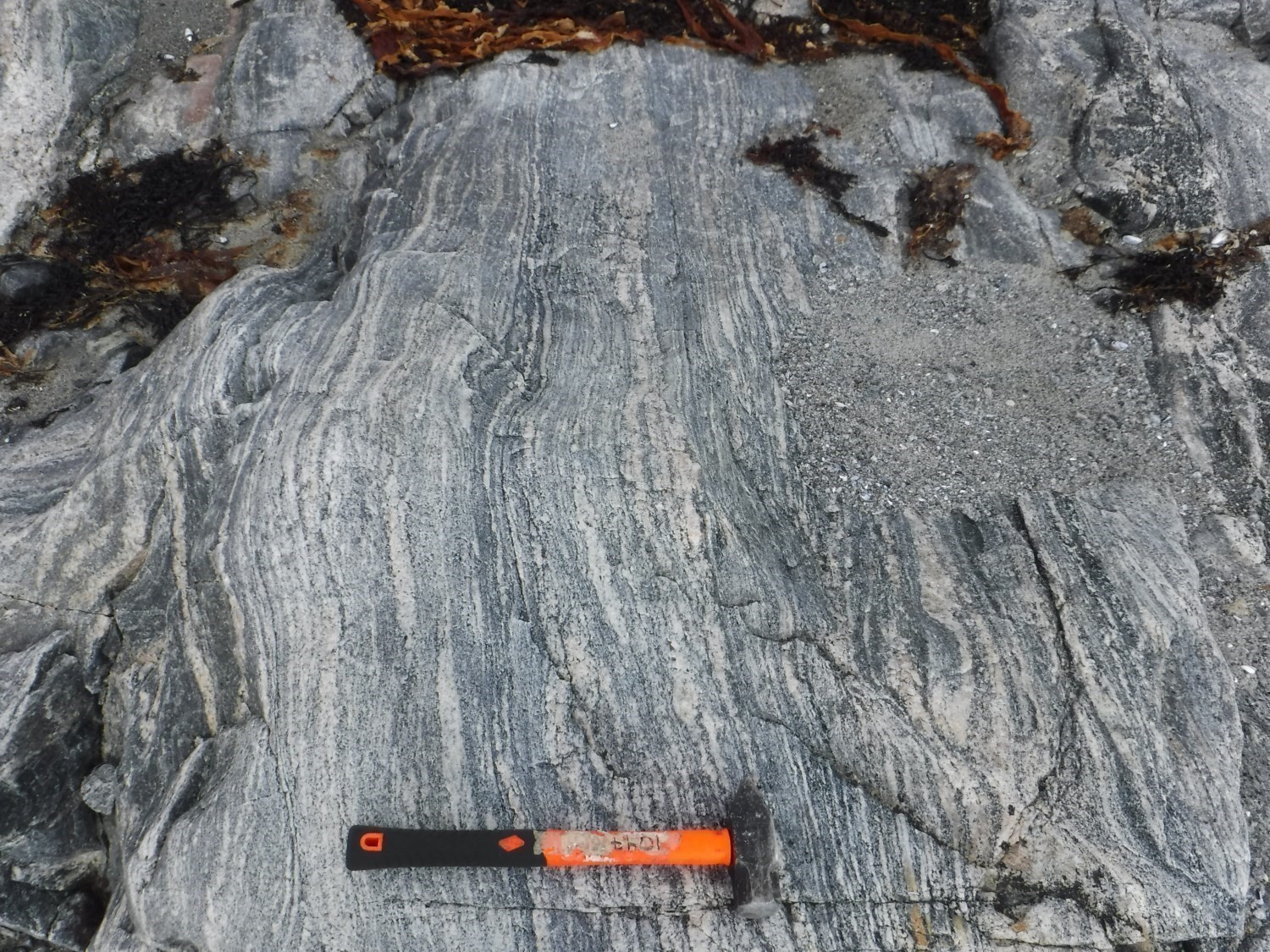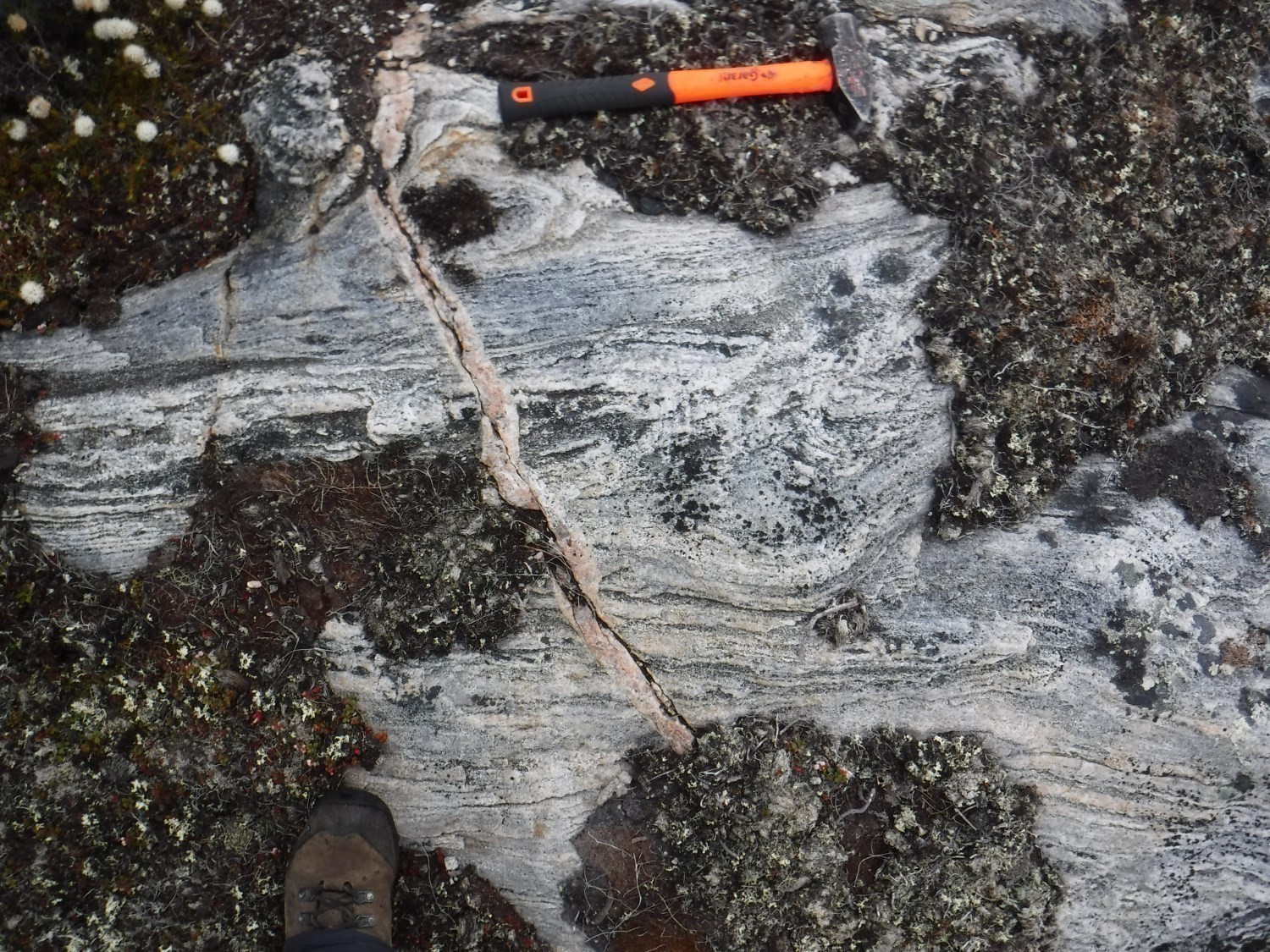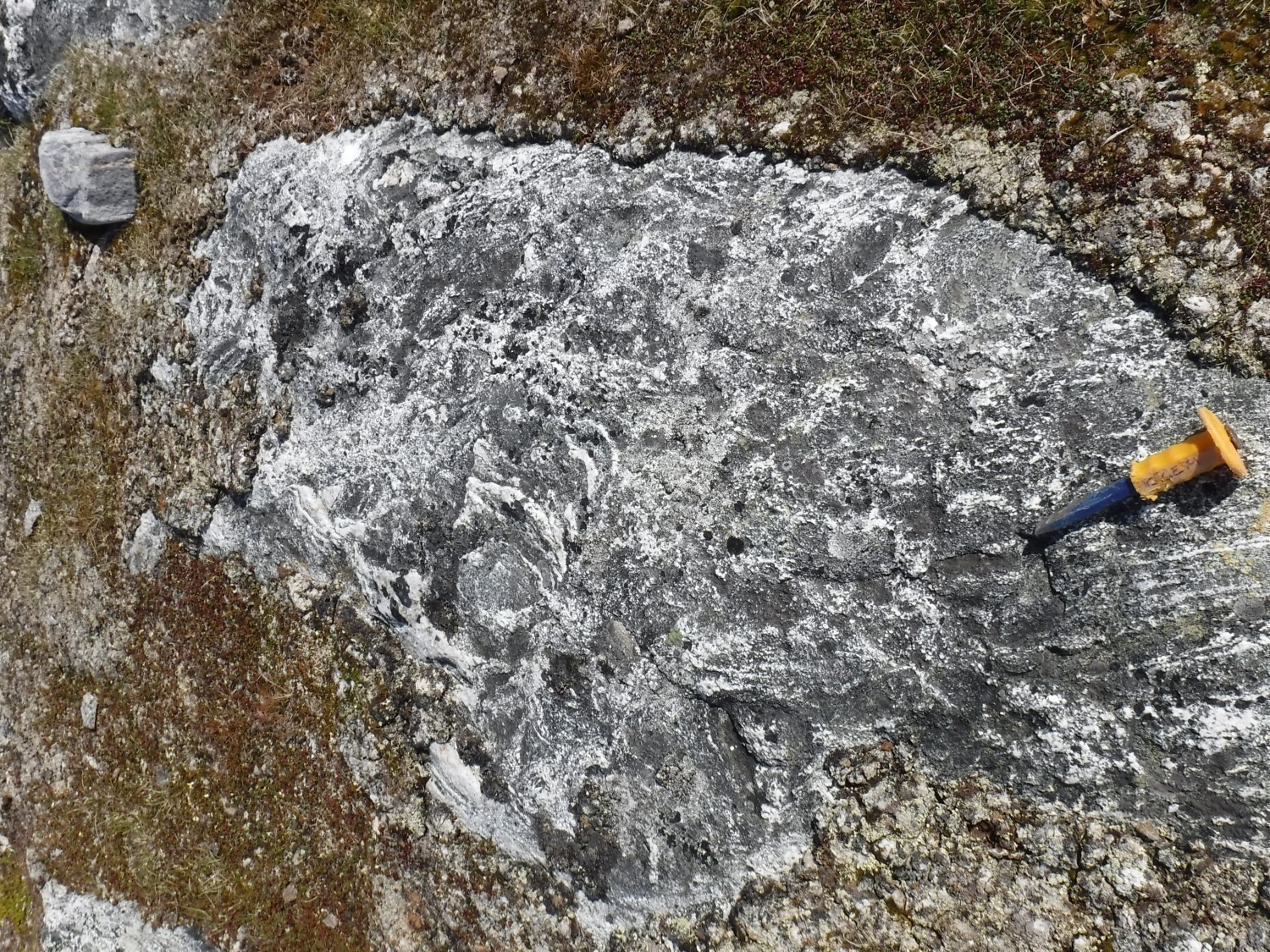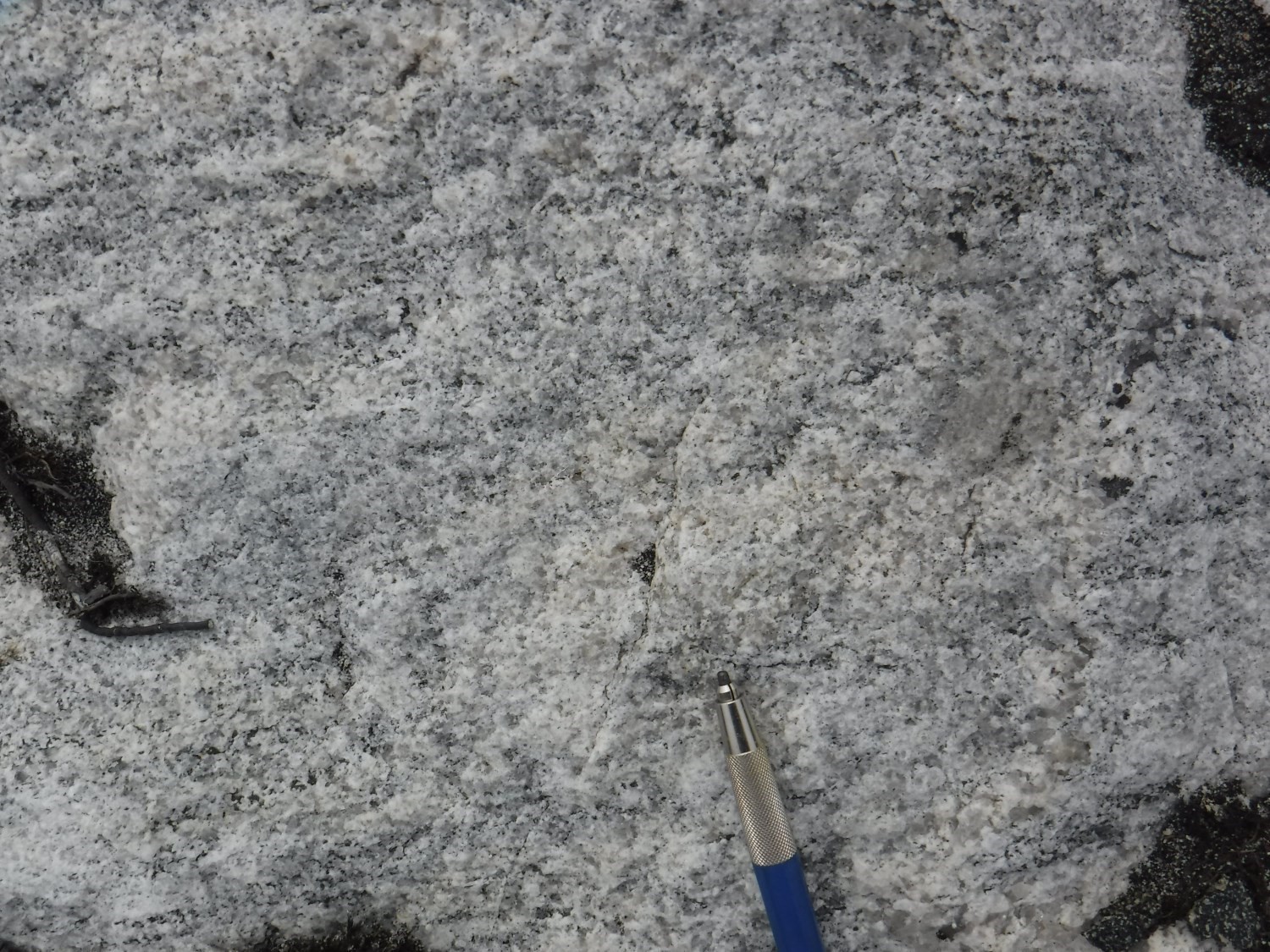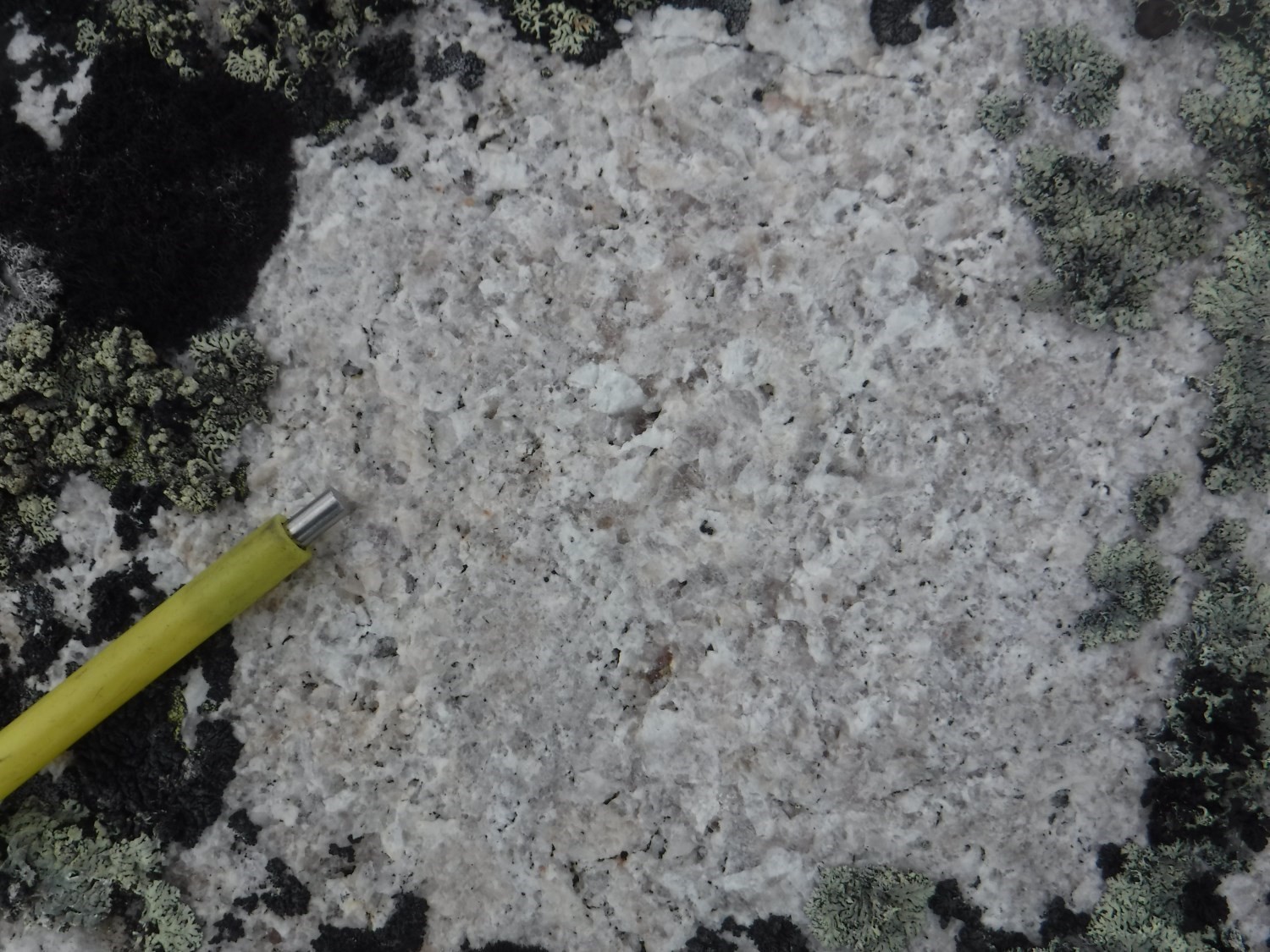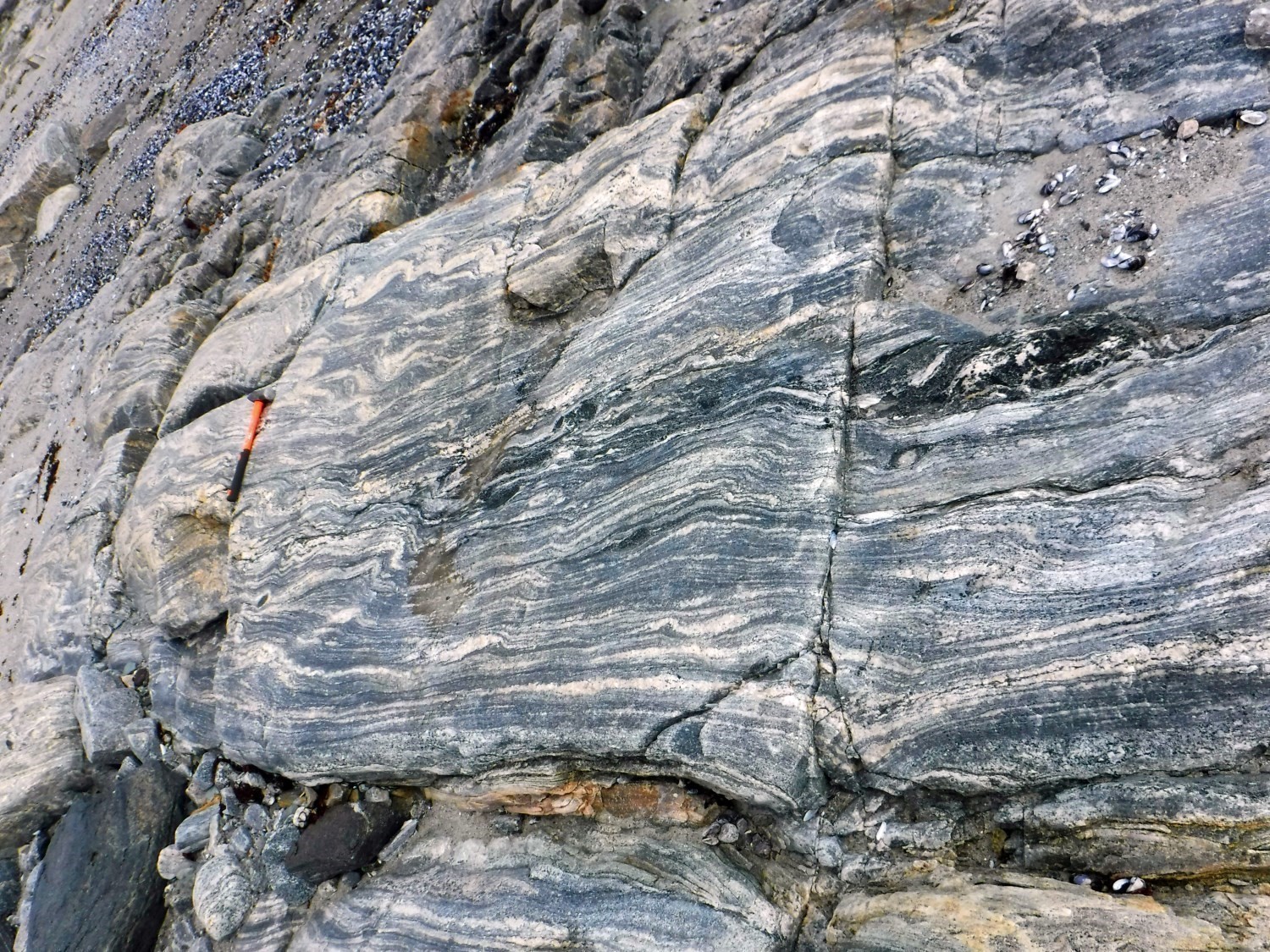
Last modified: 23 October 2020
Translation of original French
| Author: | Charette and Beaudette, 2018 |
| Age: | Archean; Paleoproterozoic |
| Stratotype: | None |
| Type area: | Northern part of the Ungava Peninsula |
| Geological province: | Churchill Province |
| Geological subdivision: | Ungava Orogen / Kovik Lithotectonic Domain |
| Lithology: | Foliated to gneissic plutonic rock assemblage |
| Category: | Lithodemic |
| Rank: | Complex |
| Status: | Formal |
| Use: | Active |
None
Background
Rocks of the Kovik Complex were first mapped by Taylor (1982) who assigned the Aphebian age to all plutonic rocks lying north of the Southern Domain (also known as the Cape Smith Belt or Ungava Trough). Doig (1983, 1987) has shown through Rb/Sr datings ranging from 2934 to 2569 Ma, that rocks of the Déception Bay, which he calls « Déception Gneiss », are Archean. In most of the Ministère’s work, the term « Déception Group » has been used to describe the rocks forming the internal northern bedrock (Lamothe et al., 1984; Tremblay, 1991; Barrette, 1990a, 1990b). This term was abandoned by Lamothe (2007) who introduced the name “Kovik Antiform”, as suggested by Hocq (unpublished), as a lithodemic unit. However, this name does not comply with the rules of the North American Stratigraphic Code (1983, 2005). As a result, Charette and Beaudette (2018) preferred to transform the Kovik Antiform into a lithotectonic domain and introduced the “Kovik Complex” to describe geological units of this area.
The Kovik Complex stratigraphic subdivision is based on Lamothe (2007). and Vanier and Lafrance (2020) extended the Kovik Complex from 5 to 20 km north in the western part of the Kovik doain. Charette and Beaudette (2018) also introduced units of gabbro and banded diorite, with garnet locally (ApPkvk2a), metatexite and diatexite derived from partial melting of metasedimentary rocks (ApPkvk3a and 3b, respectively), and migmatitized quartz diorite (ApPkvk6a). Vanier and Lafrance (2020), however, reassigned subunits Appkvk3a and Appkvk3b of Charette and Beaudette (2018) to the Crony Suite. As the Ministère’s mapping work is completed, these units will be better defined and re-assigned to distinct suites depending on their composition and genetic class. The Kovik Complex will then be abandoned.
Description
The Kovik Complex consists of an Archean rock assemblage of the parautochtonous bedrock underlying the Ungava Orogen allochtonous units. This assemblage is composed principally of biotite ± hornblende ± epidote ± titanite ± allanite tonalite or granodiorite (ApPkvk4, ApPkvk5 and ApPkvk6) with varying proportions of mafic and metasedimentary rock enclaves (Taylor, 1982; St-Onge and Lucas, 1990, 1992). Scarce klippes of siliciclastic metasedimentary rocks (ApPkvk3), and mafic and intermediate igneous rocks (ApPkvk1) are preserved within or on the edges of tonalitic intrusions. Late metric to kilometric intrusions, varying from tonalitic to syenogranitic (ApPkvk7 to ApPkvk10), intrude into tonalite and granodiorite (St-Onge and Lucas, 1992).
Kovik Complex 1 (ApPkvk1): Amphibolite and Garnet Hornblendite
Information pertaining to unit ApPkvk1 is limited as it was only described by Moorhead (1996) and Charette and Beaudette (2018). The rock is fine to very fine grained, black in altered surface and green in fresh exposure. The appearance of amphibolite varies from massive to banded. When present, a compositional variation is marked by milimetric to centimetric melanocratic bands containing clinopyroxene and hornblende as well as decimetric to metric massive ultramafic horizons. In places, discontinuous millimetric bands of leucosome (up to 7%) are observed parallel to foliation. In hornblendite, hornblende forms up to 90% of the rock. It is associated with diminishing amounts of quartz, garnet, chlorite, sphene and ilmenite. Hornblende is generally unaltered; locally, in contact with garnet, it exhibits partial chloritization and biotitization.
Kovik Complex 2 (ApPkvk2): Quartz Diorite and Gabbro
Mafic and ultramafic rocks of unit ApPkvk2 form kilometric klippes and masses between the vast tonalite massifs and granitic plutons, as well as enclaves digested by these clusters. At the outcrop scale, these rocks are associated with tonalite in two ways: (1) interstratification of diorite and tonalite, apparently comagmatic; and 2) angular, low-elongation enclaves of diorite, amphibolite, pyroxenite and peridotite in tonalite (agmatitic texture).
Sparse late diorite plutons, even-grained and medium-grained, cut tonalite plutons and form bodies hundreds of metres to several kilometres in diameter. A small mafic intrusive rock composite complex intruding into tonalite was mapped in more detail on the NE side of Deception Bay. This complex mainly consists of hornblende-biotite quartz diorite, which changes to hornblende-biotite tonalite towards the interior of the pluton. Quartz diorite contains enclaves of pyroxenite, diorite and tonalite (Lucas and St-Onge, 1997). There is a diorite phase associated with quartz diorite in which ovoid plagioclase phenocrystals up to 3 cm in length dominate. Plagioclase phenocrystals have a hornblende core, and garnet inclusions are present locally. Clinopyroxene-hornblende-biotite pyroxenite forms a distinct second intrusive phase associated with quartz diorite and surrounding it. All units of the intrusive complex are cut by monzogranite veins. Foliated borders and a massive core, cut by well-defined shear zones, characterize the complex (Lucas and St-Onge, 1997).
Kovik Complex 2a (ApPkvk2a): Gabbro and Diorite with Banded Gabbro Layers
Subunit ApPkvk2a was introduced to distinguish mafic rocks that are commonly banded, but also occur as foliated to massive layers. Banded sequences are characterized by a compositional variation from diorite to gabbro. In several places, gabbro includes layers rich in garnet porphyroblasts (0.51 cm) rimmed by plagioclase. A melanogabbro or pyroxenite is in transitional contact with gabbro or forms centimetric to metric boudinaged layers. Banding is accentuated by leucosomes (5-15%) in bands or in discontinuous millimetric to centimetric clusters. These include garnet and clinopyroxene in places. A gneissic texture is observed locally. In places, metric bands of metasedimentary rock are interbedded in the banded mafic sequence. This banded facies is granoblastic and fine grained, while the foliated to massive facies is medium grained. The foliated to massive facies occurs as layers in banded rocks of subunit ApPkvk2a. When massive, diorite and gabbro are homogeneous and locally show a cumulate or speckled texture. Cluster leucosomes make up <10% of foliated gabbro. The main minerals are hornblende and clinopyroxene, and the main accessory minerals are sphene, calcite, apatite, actinolite and epidote. In thin sections, hornblende replaces pyroxene, which is usually observed as relics in the core of hornblende crystals.
Kovik Complex 3 (ApPkvk3): Aleurite, Pelite, Psammite, Quartzite and Paragneiss
Large klippes of fine-grained clastic metasedimentary rocks have been preserved in tonalite and monzogranite plutons. They extend mainly east of Deception Bay. The dominant composition is semi-pelite. It has a rusty patina and is, in places, interstratified with pelitic and amphibolitic bands <1 m thick. A marked stratification is characteristic of semi-pelite and pelite. These lithologies include local horizons of conglomerate, marble and amphibolite. In the Wakeham Bay area, tonalite and monzogranite massifs contain small lenses (0.5 m thick) of limestone marble (Lucas and St-Onge, 1997). In the tectonic window of the western Archean basement, metasedimentary rocks are smaller in size within the tonalite of unit ApPkvk4 and form only locally 1:100 000 mappable strips of significant length. In this area, the metasedimentary sequence mostly consists of pelite and semi-pelite, with sparse quartzite strata, indicating relatively deep water sedimentation. Granitoid veins coming from adjacent plutonic massifs or derived from local partial melting cut the sequence (Lucas and St-Onge, 1997).
Kovik Complex 4 (ApPkvk4): Biotite Tonalite and Granodiorite with Abundant Mafic Rock Enclaves
Unit ApPkvk4 is the dominant plutonic rock unit of the Kovik Complex. The foliated to gneissic texture and altered grey surface are characteristic of the rock. Within tonalite, banding is marked by a compositional variation ranging from tonalite to quartz diorite and is accentuated by 5-20% millimetric to centimetric, whitish or pinkish leucosome. The latter is granitic to tonalitic, medium to coarse grained and locally folded. A small proportion (1-5%) of decimetric diorite layers and enclaves are in sharp or transitional contact in tonalite. More highly migmatized tonalite layers, containing up to 40% leucosome bands, are present locally. Petrographic studies show that the distribution of K-feldspar is generally heterogeneous and that it is concentrated in diffuse bands. Ferromagnesian minerals are disseminated or as millimetric laminae that make up 7-25% of the mineralogy. Biotite is the main ferromagnesian mineral, followed by hornblende. Accessory minerals observed in thin sections include apatite, zircon, monazite and, locally, sphene, epidote and magnetite.
Kovik Complex 4a (ApPkvk4a): Banded Heterogeneous Migmatized Tonalite and Biotite Schlieren Tonalite
Subunit ApPkvk4a represents areas where ApPkvk4 tonalite is strongly migmatitized. When observed,contact is transitional. The rock is characterized by diffuse banding formed by millimetric to centimetric coarse-grained leucosome conformable to the tonalite. Other leucosome bands cut foliation. These are usually in sharp contact with migmatized tonalite and could represent migration zones. Subunit ApPkvk4a is medium to coarse-grained, contains 10-15% biotite schlierens or discontiuous laminae and 5-10% centimetric diorite enclaves. In places, finer-grained, less-migmatized tonalite klippes could represent paleosome rafts. Biotite is the main ferromagnesian mineral.
Kovik Complex 4b (ApPkvk4b): Biotite Schlieren Heterogeneous Migmatite
Migmatite of subunit ApPkvk4b, recognized by its heterogeneous appearance, is derived from partial melting of unit ApPkvk4 tonalite. In places, the rock has a heterogranular speckled intrusive appearance with biotite clusters; elsewhere, it displays chaotic banding. Large amounts of leucocratic anatectic granite is commonly observed in outcrop. This subunit contains centimetric bands or partially digested metric enclaves of dioritic composition that may resemble restites. Subunit ApPkvk4b contains a high proportion (20-40%) of millimetric to centimetric leucosome bands that form ptygmatitic folds. In banded areas, the mobilisate is generally conformable to foliation; in places, it cuts foliation to give it an anastomosed appearance. At the edge of the mobilisate, ferromagnesian minerals are coarser grained. They account for 5-15% of the migmatite’s mineralogy and their distribution is heterogeneous, even though they are more concentrated in schlierens. This subunit shows local chloritization and epidotization. In thin sections, epidote is coarse and accounts for 5-10% of the mineralogy. Chlorite, on the other hand, forms small crystals associated with epidote.
Kovik Complex 5 (ApPkvk5): Biotite Tonalite and Granodiorite with Sparse Mafic Rock Enclaves, Tonalitic Gneiss and Granodioritic Gneiss
Unit ApPkvk5 was described by St-Onge and Lucas (1992) and St-Onge et al. (1992) to distinguish areas where tonalite and granodiorite of the complex contain few enclaves. Indeed, unit ApPkvk5 contains a smaller amount of mafic rock enclaves than unit ApPkvk4. The informal unit also has distinct mineralogy: hornblende is the main ferromagnesian mineral of unit ApPkvk5, whereas it is biotite for unit ApPkvk4.
Kovik Complex 6 (ApPkvk6): Hornblende-Biotite Tonalite and Quartz Diorite
Unit ApPkvk6 contains less K-feldspar than units ApPkvk4 and ApPkvk5. Tonalite is marked by banding forming quartz diorite strata or bands. Like unit ApPkvk5, the main ferromagnesian mineral is hornblende. Biotite occurs is smaller amounts.
Kovik Complex 6a (ApPkvk6a): Quartz Diorite and Migmatized Tonalite
Subunit ApPkvk6a consists of homogeneous, well foliated lithologies varying from quartz diorite to tonalite and containing small, recrystallized plagioclase phenocrystals. This subunit is commonly observed in transitional contact with ApPkvk4 tonalite. Within subunit ApPkvk6a, millimetric to centimetric discontinuous leucosome bands account for 5 to 10% of the lithology. In places, quartz diorite horizons have a gneissic or banded appearance where the proportion of leucocratic bands reaches 20 to 45% of the lithology. Local centimetric to decimetric gabbro layers are also observed. These mafic layers are boudinaged in places and generally account for <20% of the outcrop. In subunit ApPkvk6a, the quartz content varies from 0 to 20% and plagioclase form small polycristalline clusters (recrystallized phenocrystals) 0.5-1 cm. Ferromagnesian minerals account for 17 to 35% of lithology and are distributed homogeneously or in small clusters. The main ferromagnesian mineral is hornblende with lesser amounts of biotite. Both are locally chloritized. The main accessory minerals include chlorite, apatite, zircon, sphene and epidote.
Kovik Complex 7 (ApPkvk7): Hornblende-Biotite Tonalite and Granodiorite
SW of Foul Bay, two hornblende-biotite tonalitic to granodioritic plutons intruded into older tonalite. These younger intrusie rocks are fine grained, foliated and isogranular. Both plutons contain numerous amphibolite and quartz diorite enclaves.
Kovik Complex 8 (ApPkvk8): Biotite Granodiorite and Tonalite with Mafic Rock Enclaves Locally
Plutons of Unit ApPkvk8 cut tonalite intrusions. They are generally characterized by granulite facies mineral assemblages and by tectonic foliation of varying intensity. These granotoids are gnerally massive, whereas others are only massive in their cores. These granitoids typically contain centimetric to kilometric xenotliths of tonalite, quartz diorite, amphibolite and pyroxenite (St-Onge et al., 1992). Foliated or massive, plutons are tabular and oriented E-W. They appear to have developed parallel to the E-W tectonic foliation in tonalite. Biotite is the main ferromagnesian mineral. Muscovite, hornblende and epidote are also observed in thin sections and make up <1% of the rock.
Kovik Complex 9 (ApPkvk9): Monzogranite and Porphyritic Biotite Monzonite
Of the granitic rocks cutting older tonalite, monzogranite is the most abundant. Pluton composition, however, can vary from fine-graned granodiorite on the edge to coarse-grained syenogranite near the centre. In outcrop, plutonic rocks are homogeneous, white to pinkish, foliated or massive and usually contain centimetric to kilometric enclaves of tonalite, quartz diorite, amphibolite and pyroxenite. However, petrographic studies indicate an heterogeneity (diffuse phases) that is produced by the variation in K-feldspar content (10-75%). Unit ApPkvk9 also includes a monzonite, locally gneissic, which contains centimetric K-feldspar phenocrystals. The rock is composed of 10-30% orthoclase, 25-40% plagioclase, 10-25% quartz and 5-20% ferromagnesian minerals, mainly biotite. In places, hornblende is also present, but in smaller amounts. Magnetite, muscovite and epidote are locally observed. In places, apatite forms millimetric crystals that can account for up to 3% of the rock.
Kovik Complex 10 (ApPkvk10): Biotite Syenogranite and Pegmatite
Information available for this unit is limited. Syenogranite of unit ApPkvk10 contains mainly biotite as ferromagnesian mineral. However, hornblende is locally observed. It may have a pegmatitic texture.
Thickness and Distribution
The Kovik Complex occupies the central part of the Ungava OrogenIt is currently the main unit in the Kovik Domain. In the western part of this domain, the Sugluk Shear Zone marks the boundary between the northern part of this domain and the Narsajuaq Lithotectonic Domain.
Unit ApPkvk4 forms most of the Kovik Complex. Late, small tonalite, granodiorite and monzogranite plutons of units ApPkvk7, ApPkvk8 and AKpPkvk9 intruded in unit ApPkvk4 tonalite and granodiorite. ApPkvk9 monzogranite is commonly found as veins and intrusions in tonalite (ApPkvk4) and quartz diorite (ApPkvk6a), and can locally account for up to 40% of outcrops. The only syenogranite and pegmatite mapped pluton of unit ApPkvk10 is located in the eastern part of the Kovik Domain.
Dating
Two U-Pb datings on zircons in biotite ± hornblende tonalite (ApPkvk5) indicated protolith ages of 2882 +44/-28 Ma (Parrish, 1989) and 2737 ±2 Ma (Scott and St-Onge, 1995). A sheared tonalite klippe incorporated into the basal decollement between the Kovik Domain and sedimentary rocks of the Povungnituk Group yielded a U-Pb age on zircons of 2780 ±4 Ma (Parrish, 1989). A small composite complex of mafic intrusive rocks (ApPkvk2), mapped on the NE side of Deception Bay intruding tonalite, was dated by the U-Pb zircon method at 2740 ±10 Ma (Parrish, personal communication, 1992). Four Rb-Sr ages of total rocks were obtained on paragneiss and orthogneiss of the Kovik Complex. These indicate crystallization ages between 2569 ±83 Ma and 2934 ±77 Ma (Doig, 1983). A Paleoproteozoic crystallization age obtained by Davis and Sutcliffe (2018) in a homogeneous tonalite assigned to unit Appkvk4 indicates that the Kovik Complex is not solely composed of Archean units.
| Unit | Sample Number | Isotopic System | Mineral | Crystallization Age (Ma) | (+) | (-) | Reference(s) |
| ApPkvk5 | D244A-86 | U-Pb | Zircon | 2882 | 44 | 28 | Parrish, 1989 |
| ApPkvk4 | D156 | U-Pb | Zircon | 2737 | 2 | 2 | Scott and St-Onge, 1995 |
| ApPkvk | D245-86 | U-Pb | Zircon | 2780 | 4 | 4 | Parrish, 1989 |
| ApPkvk4 | 2017-LP-2065A | U-Pb | Zircon | 1852 | 6 | 6 | Davis and Sutcliffe, 2018 |
Stratigraphic Relationship(s)
Tremblay (1991) and Lamothe (1994) indicate that the contact between the Archean basement responsible for the antiform and allochtonous rocks of the orogen is generally marked by a decollement fault, except in very rare places where basal conglomerate metric lenses are preserved. Charette and Beaudette (2018) propose that contact between the Kovik Complex and units of the Narsajuaq Lithotectonic Domain correspond to an important tectonic structure, the Sugluk Shear Zone.
Units ApPkvk2 to ApPkvk 6 are ancient plutons forming the Archean basement into which granitic veins were injected. Migmatites of subunits ApPkvk4a and ApPkvk4b are in transitional contact with unit ApPkvk4 tonalite and are interpreted as derived from melting of this tonalite. Migmatite form metric layer in tonalite and elongated kilometric masses that are oriented in the E-W structural grain. Different lithologies are visible as enclaves in migmatite, namely unit ApPkvk2a gabbro and diorite, migmatized paragneiss of the Crony Suite, and unit ApPkvk6a quartz diorite. Unit ApPkvk6a quartz diorites are commonly observed in transitional contact with unit ApPkvk4 tonalite. Because of its intermediate composition, quartz diorite present in the western portion of the antiform was assigned to unit ApPkvk6, which had been defined by St-Onge et al. (1992), but appear to be comagmatic with unit ApPkvk4 tonalite.
In all older cartographic units, granitic veins show varying degrees of deformation; they appear to be related to the episode of voluminous granitic plutonism, contemporary to deformation (Lucas and St-Onge, 1995). This hypothesis is corroborated by the relative absence of granitic veins in granitic massifs and the overall variable deformation states of both veins and granitic plutons. Granitic rocks that cut older tonalite of unit ApPkvk4 group rocks varying from granodiorite (ApPkvk8) to syenogranite (ApPkvk10), although monzogranite (ApPkvk9) is arguably the most abundant type. Based on pluton geometry and deformation, it appears that the oldest units are granodiorite and monzogranite and that the syenogranite pluton (ApPkvk10) is the most recent.
Paleontology
Does not apply.
References
Publications Available Through SIGÉOM Examine
BARRETTE, P D. 1990a. GEOLOGIE DE LA REGION DU LAC BILSON (FOSSE DEL’UNGAVA). MRN. ET 88-15, 36 pages and 3 plans.
BARRETTE, P D. 1990b. GEOLOGIE DE LA REGION DU LAC BOLDUC (FOSSE DE L’UNGAVA). MRN. ET 89-03, 48 pages and 3 plans.
CHARETTE, B., BEAUDETTE, M. 2018. Geology of the Cape Wolstenholme Area, Ungava Orogen, Churchill Province, Southeast Ivujivik, Quebec, Canada. MERN. BG 2018-03, 2 plans.
DAVIS, D W., SUTCLIFFE, C N. 2018. U-Pb Geochronology of Zircon and Monazite by LA-ICPMS in Samples from Northern Quebec. UNIVERSITY OF TORONTO. MB 2019-01, 113 pages.
HOCQ, M., VERPAELST, P., CLARK, T., LAMOTHE, D., BRISEBOIS, D., BRUN, J., MARTINEAU, G. 1994. GEOLOGIE DU QUEBEC. MRN. MM 94-01, 172 pages.
LAMOTHE, D. 2007. LEXIQUE STRATIGRAPHIQUE DE L’OROGENE DE L’UNGAVA. MRNF. DV 2007-03, 66 pages and 1 plan.
MOORHEAD, J. 1996. GEOLOGIE DE LA REGION DU LAC HUBERT (FOSSE DE L’UNGAVA). MRN. ET 91-06, 121 pages and 4 plans.
N A C S N. 1986. CODE STRATIGRAPHIQUE NORD-AMERICAIN. DV 86-02, 76 pages.
TREMBLAY, G. 1991. GEOLOGIE DE LA REGION DU LAC LESSARD (FOSSE DE L’UNGAVA). MRN. ET 88-09, 32 pages and 2 plans.
VANIER, M A., LAFRANCE, I. 2020. Géologie de la région du lac Sirmiq, Orogène de l’Ungava, Nunavik, Québec, Canada. MERN. BG 2020-02, 1 plan.
Other Publications
BARAGAR, W.R.A. 2015. Geology of part of Kovik Bay map area (NTS 35-F). Geological Survey of Canada; Open File 7846, 21 pages. https://doi.org/10.4095/296431
DOIG, R. 1983. Rb-Sr isotopic study of Archean gneisses north of the Cape Smith fold belt, Ungava, Quebec. Canadian Journal of Earth Sciences; volume 20, n°5, pages 821-829. https://doi.org/10.1139/e83-072
DOIG, R. 1987. Rb-Sr geochronology and metamorphic history of Proterozoic to early Archean rocks of the Cape Smith fold belt, Quebec. Canadian Journal of Earth Sciences; volume 24, pages 813-825. https://doi.org/10.1139/e87-079
LUCAS, S.B., ST-ONGE, M.R. 1997. Geology, Montagne Pinguk, Quebec-Northwest Territories / Géologie, Montagne Pinguk, Québec–Territoires du Nord-Ouest. Geological Survey of Canada; »A » series Map 1912A. https://doi.org/10.4095/209062
PARRISH, R.R. 1989. U-Pb geochronology of the Cape Smith Belt and Sugluk block, nothern Quebec. Journal of the Geological Association Géologique of Canada, Volume 16, numéro 3, pages 126-130. https://journals.lib.unb.ca/index.php/GC/article/view/3609
SCOTT, D.J., ST-ONGE, M.R. 1995. Constraints on Pb closure temperature in titanite based on rocks from the Ungava orogen, Canada: Implications for U-Pb geochronology and P-T-t path determinations. Geology; volume 23, n°12, pages 1123-1126. https://doi.org/10.1130/0091-7613(1995)023<1123:COPCTI>2.3.CO;2
ST-ONGE, M.R., HENDERSON, I., BARAGAR, W.R.A. 2006. Géologie, ceinture de Cap Smith et environs, péninsule de l’Ungava, Québec-Nunavut. Geological Survey of Canada; Open file 4930, 1 scale 1/300 000 map. https://doi.org/10.4095/221810
ST-ONGE, M.R., LUCAS, S.B., PARRISH, R.R. 1992. Terrane accretion in the internal zone of the Ungava orogen, nothern Quebec. Part 1: Tectonostratigraphic assemblages and their tectonic implications. Canadian Journal of Earth Sciences; volume 29, pages 746-764. https://doi.org/10.1139/e92-064
LUCAS, S.B., ST-ONGE, M.R. 1992. Terrane accretion in the internal zone of the Ungava orogen, northern Quebec. Part 2: Structural and metamorphic history. Revue canadienne des sciences de la Terre; 1992, volume 29, n°4, pages 765-782. https://doi.org/10.1139/e92-065
ST-ONGE, M.R., LUCAS, S.B. 1990. Evolution of the Cape Smith belt: Early Proterozoic continental underthrusting, ophiolite obduction and thick-skinned folding. In The Early Proterozoic Trans-Hudson Orogen of North America (Lewry, J.F. and Stauffer, M.R.,editors). Geological Association of Canada; special paper 37, pages 313-351.
ST-ONGE, M.R., LUCAS, S.B. 1992. New insight on the crustal structure and tectonic history of the Ungava Orogen, Kovik Bay and cap Wolstenholme, Quebec. Geological Survey of Canada; Paper 92-1C, pages 31-41. https://doi.org/10.4095/132846
TAYLOR, F.C. 1982. Reconnaissance geology of a part of the Canadian Shield, northern Quebec and Northwest Territories. Geological Survey of Canada; Memoir 399, 32 pages. https://doi.org/10.4095/109241
NORTH AMERICAN COMMISSION OF STRATIGRAPHIC NOMENCLATURE (NACSN) 1983. North American Stratigraphic Code. American Association of Petroleum Geologists Bulletin, volume 67, pages 841-875. http://archives.datapages.com/data/bulletns/1982-83/data/pg/0067/0005/0800/0841.htm
NORTH AMERICAN COMMISSION OF STRATIGRAPHIC NOMENCLATURE (NACSN) 2005. North American Stratigraphic Code. American Association of Petroleum Geologists Bulletin, volume 89, pages 1547-1591. http://dx.doi.org/10.1306/07050504129
Suggested Citation
Ministère de l’Énergie et des Ressources naturelles (MERN). Kovik Complex. Quebec Stratigraphic Lexicon. https://gq.mines.gouv.qc.ca/lexique-stratigraphique/province-de-churchill/complexe-de-kovik_en [accessed on Day Month Year].
Contributors
|
First Publication |
Benoit Charette, P. Geo., M.Sc. benoit.charette@mern.gouv.qc.ca; Mélanie Beaudette, GIT, B.Sc. melanie.beaudette@mern.gouv.qc.ca (redaction) Mehdi A. Guemache, P. Geo., Ph.D. (coordination); Mélina Langevin, GIT, B.Sc. (critical review); Simon Auclair, P. Geo., M.Sc. (editing); Ricardo Escobar Moran (HTML editing); Céline Dupuis, P. Geo., Ph.D. (English version). |
|
Revision(s) |
Isabelle Lafrance, P. Geo., M.Sc. isabelle.lafrance@mern.gouv.qc.ca; Marc-Antoine Vanier, Jr. Eng., M.Sc. marc-antoine.vanier@mern.gouv.qc.ca (redaction) Mehdi A. Guemache, P. Geo., Ph.D. (coordination); Benoit Charette, P. Geo., M.Sc. (critical review); Simon Auclair, P. Geo., M.Sc. (editing); André Tremblay (HTML editing); Céline Dupuis, P. Geo., Ph.D. (English version). |


